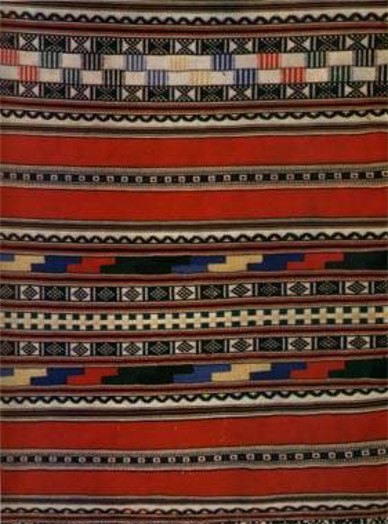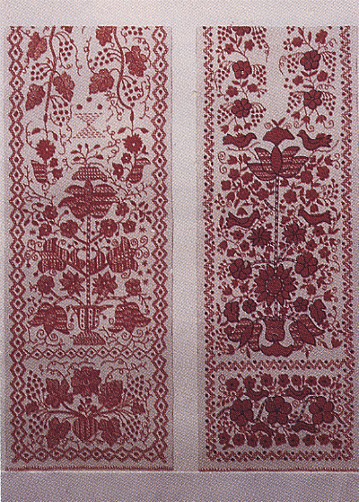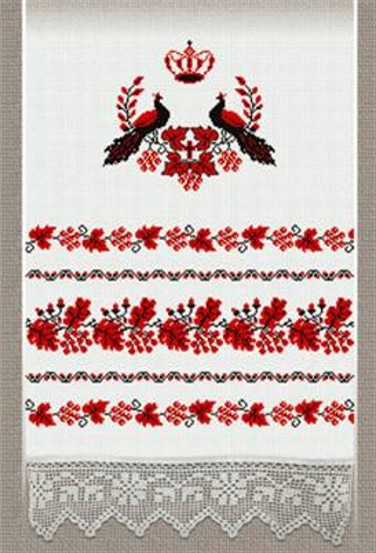Rushnyk
Rushnyk [рушник]. An embroidered or woven towel 20–50 cm wide and 1–4 m long, used usually for a decorative or ceremonial purpose. In medieval times it was used as a basic piece of dress, covering the front and back of the body, or as a monetary unit. In Ukraine the rushnyk accompanied a person throughout his or her life: a newborn was placed immediately on a rushnyk. The rushnyk played a prominent role in the wedding rituals: in the engagement ceremony and the church wedding the rushnyk was used to tie the hands of the young couple; at the shower the bride-to-be and her bridesmaids wore the rushnyk across the chest; the engaged couple or their attendants carried the rushnyk when they invited guests to the wedding; at the wedding it was the bride's chief gift to the bridegroom, her in-laws, and the matchmakers; the rushnyk was worn across the chest by the most important, if not all, wedding guests; at the departure from the bride's home and during the church service the couple stood on a rushnyk; and at the wedding the wedding bread was placed on a rushnyk. As a component of the bride's dowry the rushnyk represented her wealth and talents. The Hutsuls hung a rushnyk in the window to inform others of a death in the family. At funerals the deceased were covered with a rushnyk, the oxen pulling the hearse were decorated with it, the coffin was lowered into the grave with rushnyky, and the cross over the grave was draped with a rushnyk. A rushnyk was the most common gift made to churches. It was used in various folk rituals and celebrations—to decorate the ice cross on Epiphany and the birch tree on the Feast of the Trinity. During the Kupalo festival rushnyky and flower wreaths were used for decorating roadside crosses. The final sheaf of #grain gathered during the harvest festival was tied with a rushnyk. At Saint Andrew's festival girls hung rushnyky outside their windows at night to learn whether or not they would get married. Rushnyky were also widely used in domestic life. When a house was constructed, the final beam was hoisted into place with rushnyky, which were then given to the workmen as gifts. Special rushnyky called bozhnyky or naobraznyky decorated icons or favorite paintings in the house. The rushnyk was also a symbol of the family hearth, a link between the living and the dead. A young man leaving home received a rushnyk from his mother or betrothed.
Rushnyky are either embroidered or woven, and each region of Ukraine has its own characteristic patterns and colors. The embroidered rushnyky of the Kyiv region, Poltava region, and Chernihiv region usually have a floral design arranged vertically in the form of a vase. A basic element of the design is the tree of life, subtended by a horizontal along the edge of the rushnyk. The dominant color in the Poltava rushnyk is bright red; in the Kyiv rushnyk it is red and black or red and blue. A geometric pattern, embroidered in parallel stripes, is typical of Podilia. Stylized female animal and bird figures are also popular there. Volhynian rushnyky have geometric designs of red and blue made with a standard cross-stitch or running stitch. In Subcarpathia the dominant colors are black, red, and yellow, and the most popular stich is the nyz. In Bukovyna and the Ternopil region the rushnyky are richly embroidered, with the horizontal and vertical stripes of black and red designs often covering one-quarter of the surface.
There are two basic techniques used in rushnyk weaving, and they determine the nature of the design. Shuttle weaving is used to create a horizontal geometric design, in which red is the dominant color. Twill weaving is used for more elaborate designs, in which horizontal stripes are combined with stylized flowers and #birds as well as squares, rhombuses, rosettes, and stars.
Today rushnyky are made mostly at specialized embroidery and weaving workshops and factories that employ hundreds of artisans. Some of them—M. Stefan from Kyiv, for example, and T. Vasylieva from Kharkiv—are creative artists. Nineteen enterprises in Ukraine specialize in embroidery. The major centers are in Kyiv oblast (Ivankiv, Vasylkiv, Kaharlyk, Litky), Poltava oblast (Opishnia, Velyki Sorochyntsi, Lubny), Chernihiv oblast (Nizhyn, Pryluky), Vinnytsia oblast (Vinnytsia, Klembivka, Horodkhivka), and Lviv oblast (Chervonohrad, Berdykiv, Lviv). Since the 1960s much of the embroidery work has been mechanized. The recognized masters of hand embroidery include H. Herasymovych (the Hutsul region), Vira Roik (Symferopol), M. Havrylo (Transcarpathia), N. Liakhova and E. Talashchenko (Kyiv), A. Zaduvailo (Cherkasy), H. Hryn and O. Vasylenko (Poltava region), and Z. Chepela (Nizhyn).
Woven rushnyky are more common. They are produced by factories in Krolevets, Bohuslav, Dihtiari, and Pereiaslav. Krolevets, in Sumy oblast, has been an important weaving center of high-quality rushnyky since the 16th century. In its products the design stands out against the plain white background and consists mostly of geometric motifs of rosettes, rhombuses, vases, flowers, and especially the tree of life. Most of the design is concentrated at the ends of the cloth. The best-known weavers in Krolevets are O. Vasylenko, Z. Cherenkova, M. Datsenko, and H. Yefimenko. Other master weavers are H. Veres (Kyiv) and Hanna Vasylashchuk (Ivano-Frankivsk oblast). In the West, K. Kolotylo in Vienna is known for her embroidered rushnyky.
Virtually every ethnographic and regional studies museum in Ukraine has a collection of rushnyky. The largest belongs to the Museum of Ethnography and Crafts in Lviv. A large collection is found in the Ukrainian Center for Folk Culture «Ivan Honchar's Museum» in Kyiv.
During Soviet times, besides traditional designs there were also new ‘artificial' designs with Vladimir Lenin's and Joseph Stalin's portraits, five-point stars, hammers and sickles, and various political slogans. Rushnyky are a popular form of interior decoration in Ukraine and are exported to many foreign countries. The rushnyk often appears in folk and contemporary songs as a symbol of love, faithfulness, and patriotism.
BIBLIOGRAPHY
Ukrainskie narodnye dekorativnye rushniki (Moscow 1955)
Ukraïns'kyi vyshyvanyi rushnyk (Kyiv 1980)
Zakharchuk-Chuhai, R. Narodni khudozhni promysly URSR: Dovidnyk (Kyiv 1986)
Klid, H. ‘Tradytsiia ukraïns'koho rushnyka,’ Novi dni, June 1992
Mykola Mushynka
[This article originally appeared in the Encyclopedia of Ukraine, vol. 4 (1993).]



